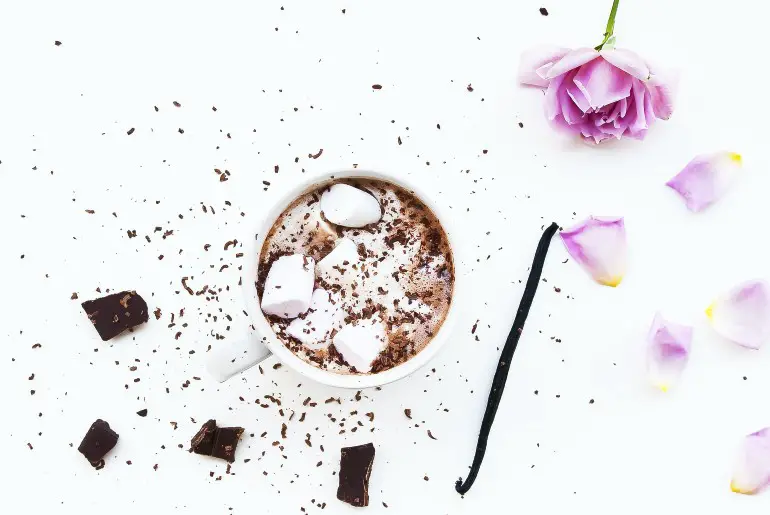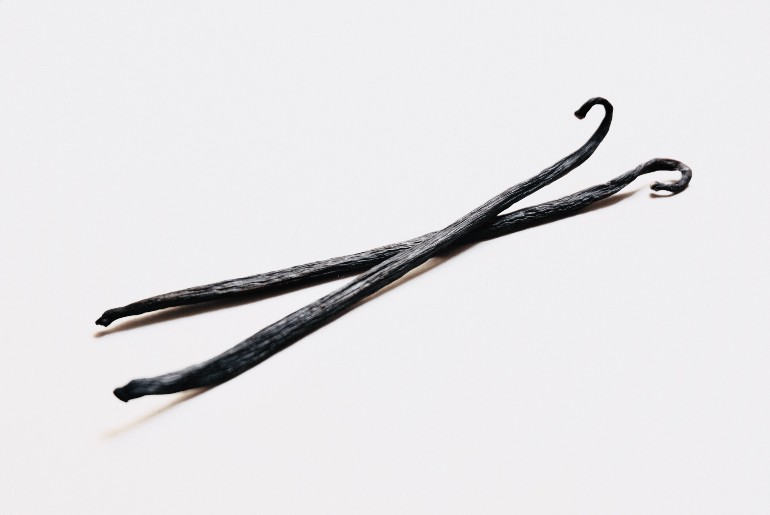Vanilla extract goes along with flour and sugar as one of the most commonly used ingredients in desserts. It is in cakes, cookies, ice cream and much more. You may even be like me and made the mistake of taking a (very disappointing) sip of vanilla extract as a child. But how much do you really know about where vanilla comes from? Read on to learn more about this ubiquitous baking ingredient.
Vanilla comes from vanilla orchids. The orchid produces a pod containing vanilla beans used in baking or used to make vanilla paste or vanilla extract. Vanilla orchids are native to South and Central America and the Caribbean and seem to have first been cultivated on the east coast of Mexico. Currently, Madagascar and Indonesia are the leading producers of vanilla, but it is also grown in Mexico, China, and Tahiti.
Vanilla orchids can only be pollinated naturally by the Melipona bee (a rare, stingless bee). Due to its shape, the flower can’t self-pollinate and is inaccessible to most pollinating insects. Only the Melipona bee evolved in a way that it can access the vanilla orchid. The Melipona bee’s natural habitat is the Yucatan Peninsula in Mexico.
The vanilla orchid only blooms one day per year, and the flower is usually only open for a few hours. Due to the lack of natural pollinators and the short window of time when vanilla orchids can be pollinated, vanilla orchids are hand pollinated. Hand pollination is labor-intensive and time-sensitive. Hand pollination requires constant monitoring to pollinate the orchid at the correct time.
Vanilla Beans
Vanilla beans are the pods that grow on the vanilla orchid 6-9 months after pollination. They are hand-picked, and workers must hand pick them at precisely the right time for the best flavor. Reportedly the best vanilla beans come from orchids grown in tropical climates.
Once picked, the beans are cleaned and placed in hot water for 2 to 5 minutes as the first step in the curing process. They then go through the “sweating” process in which workers place them in a lined, wooden box for about 48 hours. After the first sweating process, they dry on racks in the sun. Next, they alternate between the sweating box and sun drying for several weeks. Then, they are spread on racks in a ventilated room to finish drying, which can take up to a month. Next, they are placed in lined, wooden boxes for another two months. They can now be stored in an airtight container to be shipped and sold.
When picking out vanilla beans, they should be glossy and plump with a slight bend. If dry, dull or brittle they are too old. When you are ready to use them, you can cut the beans open and scrape out the seeds. One vanilla bean is the equivalent of 3 teaspoons vanilla extract. You can also use the scraped-out pods by steeping them in milk or cream or put in a jar of sugar to get vanilla-scented sugar.
If you want a more in-depth look at the behind-the-scenes of vanilla bean production, check out this YouTube video.
Vanilla Paste
Vanilla paste is a blend of vanilla bean seeds or vanilla bean powder and concentrated vanilla extract. Commercial vanilla pastes often have sugar or corn syrup, and a thickener such as gum tragacanth or xanthan gum. It has a thick, syrupy texture and is about three times stronger than vanilla extract. It can add a lot of vanilla flavor without adding as much liquid as vanilla extract does. When stored in an airtight container in a cool, dark place, it can last up to 3 years. It is on the pricey side but is worth buying for your favorite vanilla ice cream or vanilla cake.

Vanilla Extract
Natural Vanilla Extract
Vanilla beans are used to make natural vanilla extract. The flavor compound that gives vanilla its flavor is vanillin. The fermented and cured beans are ground up and soaked in alcohol and water. The result is the fragrant liquid extract you can buy at the grocery store. If you see the label “pure vanilla extract,” it uses vanilla beans from various sources. Natural vanilla extract from one place will always have a label with its country of origin.
To be considered pure vanilla extract, it must have 13.35 oz vanilla beans per gallon during extraction. In the USA, it must be at least 35% alcohol to meet FDA standards. It must also only get its vanilla flavor from vanilla beans. However, other ingredients such as sugar or corn syrup can be added because they don’t add to the vanilla flavor.
Homemade Vanilla Extract
You can also make vanilla extract can also at home. To do this, split the beans, scrape them into an airtight glass container and cover the pods with vodka or another neutral-flavored liquor. Homemade vanilla extract takes about two months to mature. While the extract matures within two months it takes 6 to 12 months for best flavor and lasts up to 5 years. Make sure to store it in a cool, dark environment.
Artificial Vanilla Extract
Does Artificial Vanilla Extract Come from Beaver Butts?
There is a common myth that food manufacturers use castoreum as the flavoring component of artificial vanilla extract. So what is castoreum? Buckle up, because this is a bit gross. Castoreum is an anal secretion that comes from beavers. It comes from the beaver’s castor sac located near the base of their tail. Beavers use it to mark their territory, and various sources report it has a pleasant vanilla scent (I cannot personally verify this, thankfully).
Castoreum has been used in perfume making for a long time. It has also been used as a food additive to enhance vanilla, strawberry, and raspberry flavoring in various foods such as ice cream, candy, and yogurt. However, currently, the use of castoreum is quite rare, mainly because it is difficult (i.e., expensive) to collect. However, it is in the USA the FDA lists castoreum as “generally recognized as safe,” and it doesn’t have to be specifically listed as an ingredient but just as “natural flavoring.” For more info, check out this Snopes article.
So How IS Vanilla Extract Made?
Synthetic vanillin is the main ingredient in imitation vanilla. Synthetic vanillin is made from either guaiacol or lignin, with 85% of artificial vanillin coming from guaiacol. Guaiacol is a yellowish, oily substance that comes from the distillation of wood-tar creosote or guaiacum tree resin. Lignan is part of woody plants that helps give them their structure, and wood pulp is used to get synthetic vanillin.
After the synthetic vanilla is made, it can be left clear but is frequently dyed with a caramel coloring. Natural vanilla extract is always a caramel brown. Artificial vanilla flavoring also contains alcohol as it acts as a preservative. If substituting imitation vanilla for natural vanilla, you will need to use more as imitation vanilla is 1/2 as strong as pure vanilla. If stored in a cool, dark place, imitation vanilla extract lasts 3 to 4 years.
Should I Use Natural or Imitation Vanilla Extract?
If vanilla isn’t the main flavor in a recipe, such as gingersnaps or a chocolate cake, you should be okay to use the more affordable imitation vanilla. However, if the majority of flavor is vanilla, such as vanilla ice cream, you’re going to want to splurge and go for the real deal.
Well, I hope you enjoyed learning more about vanilla! If you’ve now been bit by the baking bug, I highly recommend my Best Banana Cake or Triple Chocolate Cookies. Happy baking!





